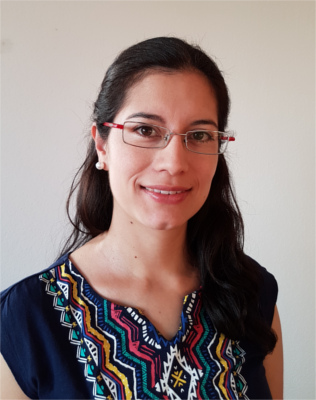Marcela Arango Ospina
Marcela Arango Ospina, M. Sc.
Aktuell: Doktorandin
Polymer derived bioactive glasses
Betreuer: Prof. Dr.-Ing. habil. Aldo R. Boccaccini
Bioactive glasses (BGs) are suitable materials for bone regeneration applications. It has been established that the presence of silicon in bioactive glasses has an effect in the osteogenesis process [1]. The intrinsic biological properties of BGs can be improved by the incorporation of therapeutic ions which are aimed to be locally released and provide continuous action and reduced toxicity [2]. Within this project, BGs based on silicon oxycarbide containing therapeutic ions will be synthesized from polymeric precursors following a methodology developed by collaborators at the Department of Disperse Materials, TU Darmstadt [3]. The novel BGs will be characterized in terms of bioactive behavior, ion release kinetics and cytotoxicity. Additionally, silicate bioactive glasses loaded with therapeutic ions will be melted and characterized. A comparison between the two families of BGs will be established. The project is funded by the German Science Foundation (DFG) and involves collaboration with Dr. Isabel Gonzalo-Juan, Dr. habil. Emanuel Ionescu and Prof. Ralf Riedel (TU Darmstadt).
[1] L. L. Hench, Opening paper 2015- Some comments on Bioglass: Four Eras of Discovery and Development, Biomed. Glassess 1 (2015) 1-11.
[2] A. Hoppe, et al., A review of the biological response to ionic dissolution products from bioactive glasses and glass-ceramics, Biomaterials 32 (2011), 2757-2774.
[3] I. Gonzalo-Juan, et al., Synthesis and in vitro activity assessment of novel silicon oxycarbide-based bioactive glasses, Materials, 9(12), (2016) 959.
Zeitraum: 2017 (Master Studentin)
Betreuer: Francesca Ciraldo, Prof. Dr.-Ing. habil. Aldo R. Boccaccini
Thema / Repräsentative Veröffentlichung:
Design and development of Ag-doped mesoporous bioactive glass based scaffolds derived from natural marine sponges
The objective of this research project is to develop and characterize bioactive glass based scaffolds (45S5 BG composition) with enhanced mechanical properties and antibacterial capability. The scaffolds will be prepared via the foam replica technique using natural marine sponges as sacrificial templates [1,2]. Integration of a mesoporous glass doped with antibacterial ions will enhance the antibacterial properties of the system [3]. The scaffolds will be characterized in terms of morphology, mechanical stability and chemical composition. Additionally, bioactivity studies, ion release analysis and antibacterial tests will be carried out.
[1] Chen, Q. Z., Thompson, I. D., & Boccaccini, A. R. (2006). 45S5 Bioglass®-derived glass–ceramic scaffolds for bone tissue engineering. Biomaterials, 27(11), 2414-2425.
[2] Boccardi, E., Philippart, A., Juhasz-Bortuzzo, J. A., Novajra, G., Vitale-Brovarone, C., & Boccaccini, A. R. (2015). Characterisation of Bioglass based foams developed via replication of natural marine sponges. Advances in Applied Ceramics, 114(sup1), S56-S62.
[3] Mouriño, V., Cattalini, J. P., & Boccaccini, A. R. (2012). Metallic ions as therapeutic agents in tissue engineering scaffolds: an overview of their biological applications and strategies for new developments. Journal of the Royal Society Interface, 9(68), 401-419.

